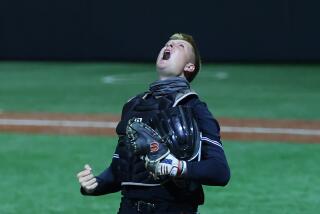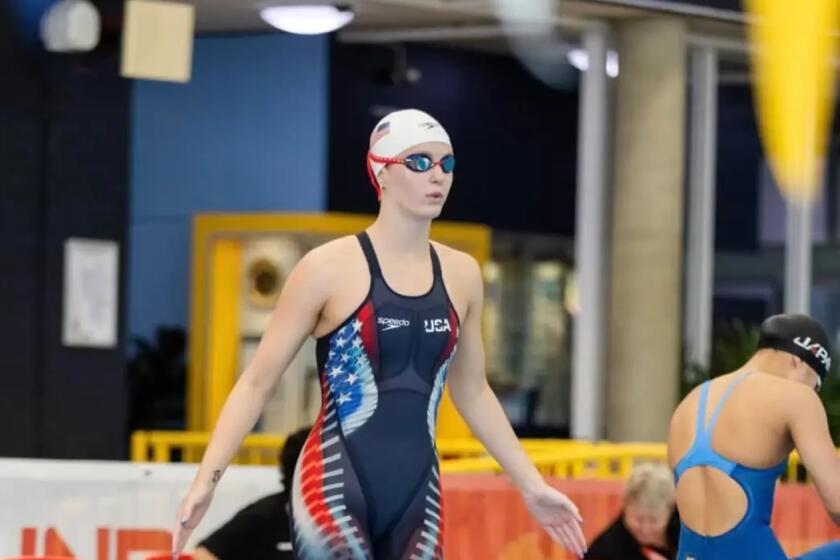PREP WEDNESDAY : The Bigger, the Better : High School Linemen Need Great Size to Measure Up to Division I Specifications
- Share via
Ask Gary Meek who Esperanza High School’s best lineman is and he’ll tell you:
“Sean Donohue.”
Ask him which Aztec lineman will be the best college player, and the Esperanza coach says:
“Matt Werner.”
Huh?
“Matt is no better than Sean, but Matt is definitely a Division I player,” Meek said. “He has everything in the same package.”
To college recruiters looking for linemen, it’s how the package is wrapped that matters more often than not.
Werner comes with a 6-foot 5-inch, 243-pound body. He is strong, fast and aggressive. Donohue weighs about the same, runs the same, plays the same. But he stands only 6-feet tall--on his toes.
Division I colleges want linemen with size--particularly height. They’ll look at a player’s aggressiveness, his quickness, his agility. But first they look at his size.
It’s a fact of life, and high school players know it. They’ll eat more and lift more to gain weight. But in terms of height, they can only hope they will grow. If they don’t, some might stretch the truth on a college questionnaire just to get on a scout’s shopping list.
“What it comes down to is colleges have a blueprint of what a lineman should be,” Valencia Coach Mike Marrujo said.
If you don’t fit the blueprint, your chances are limited. Consider, of the 22 offensive linemen listed on USC’s roster, only 3 are under 6-3, the general cutoff point of many major college recruiters. Even in the Big West Conference, only 6 of the 29 linemen signed to letters of intent in 1987 were under 6-3.
“I put on 25 pounds over the summer with the idea of playing at a Division I school,” said Donohue, a senior. “But Matt gets the attention because of his height.”
And being tall can get you noticed.
Marc Simpson of San Clemente is getting attention because of his potential. When Simpson entered high school, he was 5-9, 159 pounds. As a senior, Simpson is 6-3 1/2 and approximately 300 pounds--approximately because San Clemente’s weight scale only goes up to 300 pounds.
Simpson started playing football as a sophomore and hopes to continue in college. He has been eating with that in mind.
“I always heard size was what colleges were looking for,” Simpson said. “I’ve been working in the weight room and eating with the idea of playing football.”
He has already received letters from some Division I schools, including Washington State and Colorado.
“I get calls from schools inquiring about Marc all the time,” San Clemente coach Dave Elecciri said. “I tell them this is only his third year of football. Some lose interest, but others don’t. They feel if Marc can get down to around 280-290, he’ll be a good lineman.”
Said Simpson: “I’m dieting to get down to 280. The worst thing that will happen is I will go to Saddleback for two years, then transfer to a four-year school. Tall kids will get looked at (by recruiters) even if they’re overweight. The important thing is I grew to 6-3.”
Going too far can be a problem. Some kids develop bad eating habits in an effort to put on weight and will be forced to shed the extra baggage later in life, whether they get a scholarship or not.
Meek tells his players to put on “quality weight” by lifting weights and eating a proper diet. They can then reduce their weight easier when their football-playing days are over.
“If they don’t do it right, it can cause problems later in life,” Meek said. “You need bulk to play on the line, but you don’t have to be overweight.”
Meek, like many other coaches, is also concerned that players will take shortcuts in training. He tries to warn kids against the use of performance-enhancing drugs such as steroids.
“Steroids are out there, just like marijuana or another drug is out there,” he said. “Steroids work; Ben Johnson is proof of that. We have to start educating kids about the negative aspects. There are safer ways of building up muscles.”
No matter how much bulk a high school kid puts on, it sometimes means nothing unless he has the height.
A college coach might use a shorter player on the defensive front, provided he’s quick enough, but when it comes to offense, recruiters say the taller the better.
“I was told by a recruiter from Arizona that he was interested in (offensive) linemen 6-3 or taller,” said Chuck Gallo, Mater Dei coach. “You can tell them you have this kid who is 6-0, 200 that manhandles people, but they feel he won’t hold against a defensive line. They are only interested in big bodies.”
In a sense, the forward pass has changed the way colleges recruit linemen. The more sophisticated the offense, the taller the linemen. The general idea is you can’t sack a quarterback if you can’t get at him.
“You look at those great veer teams at Oklahoma and Alabama years ago, they could get away with smaller linemen,” Fresno State recruiting coordinator Pat Hill said. “Everything was predicated on leverage, getting low and driving a defender off the line.
“When teams started throwing more, they needed taller linemen to pass block. It takes time for a defensive player to get around those type of guys. You can’t even see the quarterback behind them.”
Every year Allan Wallace of Super Prep magazine sends out questionnaires for high school players. He asks for the basics--such as height and weight. He often gets fiction in return.
“The kids know that 6-3 is the number,” Wallace said. “If they’re close to that height, they’ll put down 6-3. They know colleges want tall players on the line.”
Wade Hogg of Troy doesn’t have to fudge on any of the details on those questionnaires.
Hogg, a 6-6, 270-pound senior, is being recruited by almost every Pac-10 school and several other major universities around the nation.
He is aggressive, knows how to block and he’s tall--a recruiter’s dream wrapped up in one package.
“When recruiters talk to me, the main thing they talk about is height,” Hogg said. “I was 6-4 as a freshmen, so I knew I was going to fall in the group they were looking for.”
Still, even average linemen in high school will be looked at and often recruited if they are big enough.
Last season Bolsa Grande had one of the most potent rushing attacks in Orange County history. All three members of the backfield (quarterback Damon Fisher, fullback Travin Lui and tailback Ricky Lepule) gained more than 1,000 yards.
Yet, the only player who received a scholarship from the team was tackle Jesse Hardwig.
“Jesse was not the best athlete on the team,” said Orange Coast College assistant coach Greg Shadid, who was Bolsa Grande’s coach last season. “But recruiters would come in to look at the film and see his potential. He wasn’t a great lineman in terms of quickness and blocking, but they were recruiting him for two or three years down the road.”
Hardwig is a 6-6, 260-pound redshirt freshman at Fresno State this season. Hill says Hardwig will likely be a starter in two years.
“Naturally, you want all your lineman to be 6-7, 270 and have 4.5 speed,” USC recruiting coordinator Jack Himebauch said. “But that’s not the way life works. Great college linemen are not always great high school players. It may take a couple years to build him up.”
As long as the frame fits the blueprint.
TWO WITH THE SIZE THAT DIVISION 1 SCHOOLS PRIZE SCOUTING REPORT:
Wade Hogg
Class: Senior.
Position: Offensive tackle.
Height: 6-feet 6-inches.
Weight: 270.
Attributes: Great size. Frame will hold the weight without sacrificing quickness. Good blocker, average speed. Has been a dominant force on the high-school level. Very good work ethic. Will only get better as a player. Wants to make it.
Drawback: Needs to work on quickness.
Outlook: He will make a very good college lineman, probably an offensive tackle.
Conclusion: Sign him.
SCOUTING REPORT:
Marc Simpson
Class: Senior.
Position: Offensive tackle.
Height: 6-feet 3 1/2-inches.
Weight: 300 plus.
Attributes: Raw talent. Has only three years experience. Great size.Could have quickness if he lost some weight. Eager to improve.
Drawback: Needs to lose 20-30 pounds.
Outlook: If he can get down to 280, might become a good offensive lineman. Definite project. Will play at a community college if necessary.
Conclusion: Could go either way, but has size. Might be worth a chance.
More to Read
Get our high school sports newsletter
Prep Rally is devoted to the SoCal high school sports experience, bringing you scores, stories and a behind-the-scenes look at what makes prep sports so popular.
You may occasionally receive promotional content from the Los Angeles Times.







